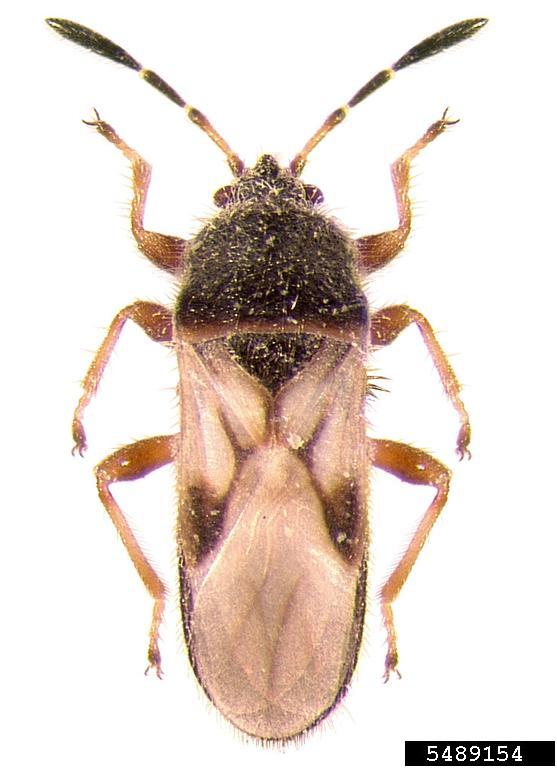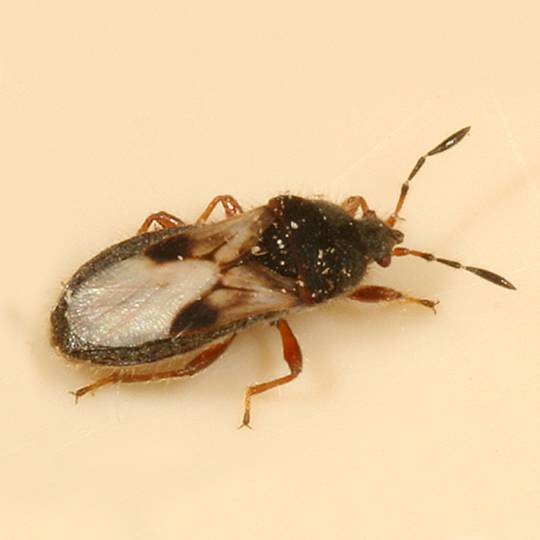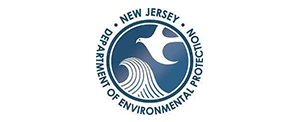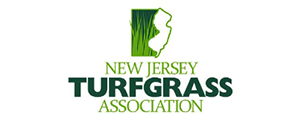Maintaining a healthy and beautiful lawn requires ongoing care and attention. Unfortunately, even the most diligent lawn care practices can sometimes fall victim to pests like chinch bugs.
These tiny insects can quickly cause extensive damage to your grass, leaving unsightly brown patches in their wake. If you’ve noticed signs of chinch bugs infestation in your lawn, it’s essential to act fast to prevent further damage.
To get rid of these pests, you need to identify chinch bugs first and what their infestations look like on your lawn.
What are Chinch Bugs?

Adult hairy chinch bug. Photo by David Shetlar, The Ohio State University, Bugwood.org
Chinch bugs are a significant threat to lawns in northeastern states like New Jersey. These pests can wreak havoc on your lawn, causing visible damage and making it difficult to maintain a healthy lawn.
The most commonly encountered chinch bug in this region is the hairy chinch bug, Blissus leucopterus hirtus Montandon. The hairy chinch bug is especially fond of perennial ryegrass, Kentucky bluegrass, red fescues, creeping bent grass, zoysia grass, and perennial rye grass, making these grasses particularly susceptible to damage.
In the winter, chinch bugs typically seek shelter under shrubs or around the foundations of houses, and as the weather warms up in the spring, they emerge and begin laying eggs.
Identifying Chinch Bugs

Life stages of hairy chinch bugs (Blissus leucopterus hirtus). Photo by David Shetlar, The Ohio State University, Bugwood.org
Eggs
Chinch bug eggs are roughly bean-shaped, with an elongated oval structure measuring around 0.84 mm in length and 0.25 mm in width. They feature a rounded point at one end and a blunt end with visible tubercles at the other.
Initially pale white in color, these eggs gradually transform into amber and eventually bright orange, marking the imminent hatch time. Generally, it takes around two weeks for the eggs to hatch, allowing the tiny nymphs to emerge.
Nymph
Chinch bug nymphs have five instars, each with distinct coloration and markings. The first instar has a brown head, bright orange abdomen, and cream-colored stripe. The second through fourth instars transition to purple-gray with two black spots. The fifth instar has visible wing pads and a black body with a blue-black abdomen and dark spots, measuring about 3 mm in length.
Adult
Adult chinch bugs are gray-black with fine hairs and reddish legs. They have white wings with a black spot on the outer margin of each forewing. Their body measures about 3.5 mm long and 0.75 mm wide, and males are slightly smaller than females.
Chinch bugs can have either short or full wings, with only full-winged adults capable of flight.
Signs and Symptoms of Chinch Bugs Infestation

Lawn with brown patches caused by chinch bugs infestation. Photo by David Shetlar, The Ohio State University, Bugwood.org
During summer, chinch bugs actively feed on plants, injecting toxic saliva as they pierce and suck plant sap. This results in discoloration in turf, changing from yellow to red or brown, along with necrosis and dead patches of grass. Injured areas may have clumps of non-grass weeds.
Although drought or heat stress can also cause browning, proper watering can revive the turf quickly. However, if the damage is due to chinch bugs, the turf will take longer to recover.
Chinch bug damage will typically begin to show in hot weather and can often be found radiating out from sidewalks or pavement where additional heat adds stress to the turf.
Treatment for Chinch Bugs Infestation
If you’re dealing with a chinch bug infestation on your lawn, it’s important to take prompt action to prevent further damage. There are several effective options for treating infested areas, which are referred to as cultural control, biological control, and chemical control.
Cultural Control
When dealing with chinch bug infestations, cultural control methods are often the most reliable in the long-term and usually more cost-effective. Properly watering the turf can have a significant impact on reducing the effect of these pests.
Using resistant turf grasses, such as perennial rye grasses, fine fescues, and tall fescues that contain endophytes can help prevent chinch bug attacks. Additionally, if your lawn has been severely damaged, overseeding with endophytic turf can aid in recovery.
Biological Control

An adult big-eyed bug on a leaf. Photo by Bradley Higbee, Paramount Farming, Bugwood.org
Another method of treating a chinch bug infestation is biological control. While some commercial formulations of Beauveria bassiana may be available, their efficacy in reducing populations to acceptable levels is questionable.
However, there is also an existence of big-eyed bugs which have been observed to kill large numbers of chinch bugs. Nevertheless, it’s crucial to bear in mind that big-eyed bugs might not build up sufficient populations until significant damage to the turf has already taken place.
Chemical Control
Chemical control is the most effective treatment of chinch bugs in the short-term, but is usually saved as a last resort. It’s best to leave this step to a professional to ensure the best results while minimizing environmental impact. They’ll often use more effective products and more precise measurements for a safer application.
If you attempt this yourself, you can typically find Bifenthrin in most garden centers or hardware stores in the pest control or lawn sections. It’s crucial to carefully read and follow the instructions on the insecticide label to ensure its safe and effective use.
It’s also important to exercise caution when using these products and wear appropriate protective gear, such as rubber gloves, long pants, and rubber boots to minimize exposure. Store unused pesticides safely in their original containers, out of reach of children and pets.
Although granular insecticides are available, they are less effective than liquid sprays. Therefore, it’s best to opt for the latter.
Chinch Bugs Prevention
Maintaining a healthy lawn is essential to preventing chinch bug infestations. Proper irrigation, mowing, and fertilization practices are key to keeping your turf stress-free and less vulnerable to pest damage.
Avoid over-irrigating, mowing too short, and over-fertilizing with nitrogen, as they can weaken your lawn and create favorable conditions for chinch bugs to thrive.
Here are a few prevention practices to avoid infestation of chinch bugs in lawn:
- Regular monitoring of landscape: Regular monitoring for signs of pest activity can help you identify issues early and choose the best course of action. To do this, check for irregular patterns of damage spreading outward, as chinch bugs tend to live in groups.
- Managing thatch buildup: Thatch buildup in your lawn can create a habitat for chinch bugs, so it’s important to manage it properly.
By following these practices, you can maintain a healthy lawn and minimize the risk of infestations.
Bottom Line
Chinch bugs can cause serious damage to lawns if left untreated, and it is important to recognize the symptoms and seek treatment promptly.
Common signs of these bugs in lawns include yellow or brown patches on the lawn, dead or wilted grass, and the presence of small, black insects with white markings.
Effective treatment options include insecticides, biological controls, and cultural practices, such as proper watering and fertilization. It’s advised to work with a professional lawn care provider like GreenStripe to determine the best course of action for your specific situation.
With proper treatment and ongoing maintenance, your lawn can recover from an infestation and thrive. Stay vigilant and take action at the first sign of trouble so you can protect your investment and enjoy a lush, healthy lawn for years to come.
Got a chinch bug problem? You can contact us to see how we can restore your lawn so it’s green and healthy.



